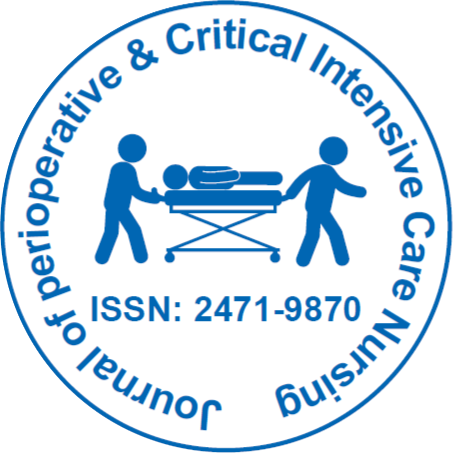
Journal of Perioperative & Critical Intensive Care Nursing
Open Access
ISSN: 2471-9870
+44-77-2385-9429

ISSN: 2471-9870
+44-77-2385-9429
Opinion Article - (2024)Volume 10, Issue 2
Patient safety is important in Intensive Care Units (ICUs), where critically ill patients require complex treatments and constant monitoring. The unique challenges of ICU environments necessitate stringent protocols, advanced technologies, and a vigilant healthcare team to mitigate risks and enhance patient outcomes. This article discusses the multifaceted aspects of patient safety in ICUs, examining strategies, challenges, and innovative approaches supported by current research and best practices. By prioritizing patient safety through rigorous adherence to protocols and ongoing training, ICU teams strive to minimize risks and uphold the highest standards of care. Research-driven innovations, such as telemedicine for remote consultations and predictive analytics for early detection of deteriorating conditions, further enhance safety measures in intensive care settings.
The complex landscape of ICU patient safety
ICUs are high-stakes environments characterized by high patient acuity, multiple comorbidities, and the potential for rapid clinical deterioration. Ensuring patient safety begins with comprehensive risk assessment and the implementation of evidence-based practices. Critical care nurses and healthcare teams play a pivotal role in promoting safety through continuous monitoring, timely interventions, and effective communication among team members. Their ability to interpret complex data and coordinate care across multidisciplinary teams ensures that patients receive timely and appropriate interventions. By embracing a proactive approach to patient safety, critical care nurses uphold standards that prioritize patient well-being and improve clinical outcomes in high-pressure ICU environments.
Strategies for enhancing patient safety
Clinical Protocols and Guidelines adherence to standardized clinical protocols, such as those for infection prevention, medication administration, and ventilator management, is important in preventing adverse events and improving patient outcomes. Multidisciplinary collaboration effective teamwork among physicians, nurses, respiratory therapists, pharmacists and other specialists encourage a culture of safety in ICUs. Regular interdisciplinary rounds and structured communication protocols ensure comprehensive care planning and decision-making. Advanced monitoring technologies innovations in monitoring technologies, such as continuous telemetry, advanced alarm systems, and remote surveillance, enable early detection of physiological changes and prompt intervention, reducing the risk of adverse events. Medication safety robust medication management systems, including barcode scanning and electronic medication reconciliation, minimize medication errors and adverse drug events in critically ill patients who often require multiple medications. Patient and family engagement: Engaging patients and their families as active participants in care decisions and safety measures promotes transparency, enhances communication, and empowers patients to advocate for their own safety.
Challenges in maintaining patient safety
Challenges in maintaining patient safety includes system improvements and care quality.
High workload and staffing issues: High patient-to-nurse ratios and fatigue among healthcare providers can compromise vigilance and decision-making, impacting patient safety.
Alarm fatigue: The proliferation of alarms in ICUs can lead to desensitization among healthcare providers, potentially delaying response to critical situations.
Communication breakdowns: Ineffective communication among healthcare team members, especially during handoffs and transitions of care, poses a risk to patient safety.
Ethical dilemmas: Balancing aggressive treatment with patient preferences and end-of-life care decisions requires careful consideration and ethical sensitivity.
Innovative approaches to enhancing ICU patient safety
Patient safety in the ICU requires innovative approaches look at some key strategies:
Simulation training: Utilizing simulation exercises to replicate critical scenarios allows healthcare providers to practice decision-making and teamwork in a controlled environment, improving readiness and response in real-life situations.
Quality improvement initiatives: Continuous monitoring of patient outcomes, adverse events, and near misses facilitates data-driven quality improvement efforts aimed at enhancing safety protocols and care delivery processes.
Human factors engineering: Applying principles of human factors and ergonomics to ICU design and workflow optimization improves efficiency, reduces errors, and enhances overall patient safety.
Patient safety in ICUs is a multifaceted endeavor that demands a proactive approach, collaboration, and continuous improvement. By implementing evidence-based strategies, leveraging advanced technologies, and encouraging a culture of safety, healthcare teams can mitigate risks and optimize outcomes for critically ill patients. As healthcare evolves, ongoing research, education, and innovation will play integral roles in shaping the future of patient safety in intensive care settings. By staying abreast of emerging research and technological advancements, healthcare teams can adapt and implement new strategies to enhance patient safety and quality of care in ICUs.
Citation: Seungei Y (2024) Implementing Effective Patient Safety Measures in ICUs: Innovative Approaches to ICU Patient Safety. J Perioper Crit Intensive Care Nurs. 10:254.
Received: 20-May-2024, Manuscript No. JPCIC-24-32840; Editor assigned: 22-May-2024, Pre QC No. JPCIC-24-32840 (PQ); Reviewed: 05-Jun-2024, QC No. JPCIC-24-32840; Revised: 12-Jun-2024, Manuscript No. JPCIC-24-32840 (R); Published: 19-Jun-2024 , DOI: 10.35248/2471-9870.24.10.254
Copyright: © 2024 Seungei Y. This is an open-access article distributed under the terms of the Creative Commons Attribution License, which permits unrestricted use, distribution, and reproduction in any medium, provided the original author and source are credited.